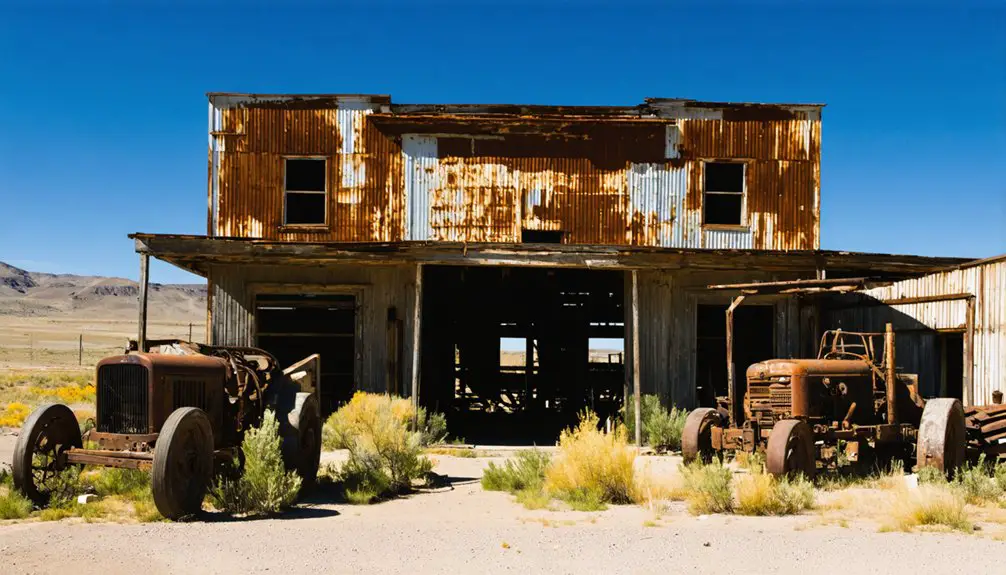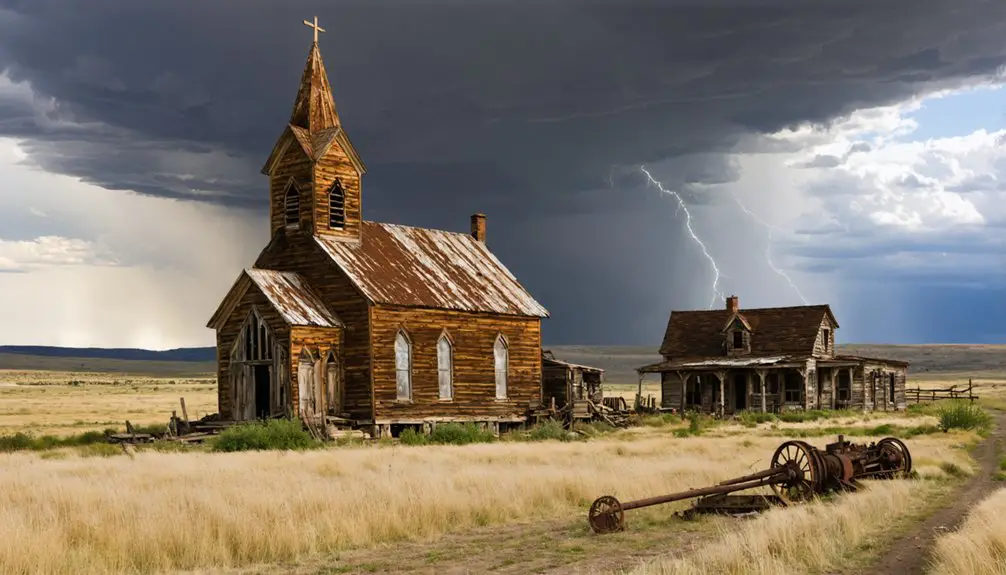You’ll find Gebo’s ghost town remnants 11 miles north of Thermopolis, Wyoming, where a once-bustling coal mining community of 2,000 residents thrived from 1906 to 1938. Founded by Canadian entrepreneur Samuel Wilford Gebo, the town featured paved streets, a hospital, and Wyoming’s largest high school. Though most buildings were demolished in 1971, you can still explore the cemetery and scattered foundations that hint at the rich cultural tapestry of this diverse mining frontier.
Key Takeaways
- Gebo was a thriving Wyoming coal mining town founded in 1906 that reached a peak population of 2,000 before closing in 1938.
- The town featured paved streets, a hospital, and the largest high school in the region during its prime years.
- At least 16 different nationalities lived and worked in Gebo, creating a diverse community centered around coal mining operations.
- Most buildings were demolished in 1971, leaving only scattered foundations and the cemetery as primary remnants of the ghost town.
- The site is accessible via dirt roads off U.S. 20, with the cemetery located a half-mile walk from the main access point.
The Birth of a Mining Frontier Town
As Wyoming’s coal mining industry flourished in the early 1900s, the frontier town of Gebo emerged in 1906 under the vision of Samuel Wilford Gebo, a Canadian-born New York entrepreneur.
You’ll find this historic settlement nestled 11 miles north of Thermopolis in Hot Springs County, where it quickly became a focal point for coal extraction.
Through Gebo’s partnership with New York investors like Rufus Ireland, the Owl Creek Coal Company established strict company ownership over the town’s development. The company provided rent-free housing to miners and their families.
The venture began with the Jones Mine, later renamed Gebo #1, while maneuvering complex mining regulations and federal coal leasing policies.
Strategic positioning near the Chicago Burlington and Quincy Railroad line proved vital, as the town capitalized on growing demands for locomotive fuel and industrial coal supplies throughout the region. The town’s success led to rapid growth, reaching a peak population of 2,000 during its prime years.
Life in Gebo’s Golden Era
During Gebo’s peak years, you’d find a bustling mining town where over 2,000 residents enjoyed amenities like paved streets, a hospital, and the region’s largest high school.
You could catch the Gebo Miner’s Band performing summer concerts behind the Pool Hall, where children gathered for candy and miners exchanged their pool hall chips.
The community’s social fabric was woven through baseball games, boxing matches, and the popular Labor Day celebrations that drew thousands from across the Big Horn Basin. The town’s founder Samuel Wilford Gebo established the mining operations that would define the community for decades to come. Sadly, many graves of infants in the local cemetery bear witness to the devastating epidemics that swept through the town.
Daily Mining Town Life
While many mining towns dotted Wyoming’s landscape in the early 1900s, Gebo stood out as Hot Springs County’s largest settlement with over 2,000 residents at its peak.
You’d find yourself among at least 16 different nationalities, working shoulder-to-shoulder in the mines where mining hazards were a daily reality. Despite the dangers, you could take pride in producing some of the highest quality coal in the region, burning hot with minimal ash.
After your shift, you’d join the vibrant community rituals at the local pool hall, boarding houses, or town band performances. The higher paying wages attracted diverse miners from across the region.
While tensions sometimes ran high among workers from different backgrounds, Gebo’s infrastructure supported a surprisingly rich social life. The town’s pool hall brawls occasionally turned deadly, as evidenced by a fatal 1931 dispute between Serbian miners.
The town’s diverse workforce shaped daily routines, from shared meals to cultural celebrations.
Cultural Diversity Shapes Community
Life in Gebo flourished with remarkable cultural diversity, bringing together more than 16 different nationalities under the common pursuit of coal mining. You’d find Finns, Czechs, Serbians, and even two Japanese families sharing their unique customs and traditions.
The community’s cultural integration manifested through amateur nights where you could hear native songs alongside American patriotic tunes. Workers earned a meager three dollars fifty cents per day for their demanding labor.
Despite the mining company’s control over daily life, cultural expression thrived. You’d witness both men’s and women’s bands performing regularly, while the community building hosted plays that united residents across ethnic lines. Students were required to learn English by Christmas to help bridge language barriers.
Even during the devastating 1918 influenza and 1920 diphtheria epidemics, community resilience emerged as families supported one another, transcending cultural boundaries.
Today, the town’s cemetery stands as a monument to this shared history, where visitors honor graves with coins reflecting bonds of friendship and family.
Cultural Mosaic of the Mining Community
As one of Wyoming’s most diverse mining settlements, Gebo hosted an extraordinary cultural mosaic comprising 16 different nationalities at its peak.
You’d have encountered European immigrants and other foreign-born residents who brought their rich traditions, languages, and customs to this bustling coal-mining town. This vibrant cultural exchange created a unique community where different ethnic groups shared not just their labor in the mines, but also their distinctive ways of life.
In this company town of over 2,000 residents, you’d have witnessed how community traditions shaped daily life.
Despite language barriers and the challenges of American assimilation, families maintained their cultural identities while forging new bonds through shared experiences in mining, education, and social activities.
Immigrant families preserved their heritage while building community through shared work, learning, and celebrations in early Wyoming’s mining towns.
The town’s diversity became its strength, creating an environment where multiple cultures thrived together.
Facing Disease and Loss
You’ll find stark evidence of Gebo’s harsh realities in its cemetery, where numerous small graves mark the final resting places of children and infants claimed by disease outbreaks in the early 1900s.
Living conditions in the mining camp, with limited medical care and poor sanitation, left families particularly vulnerable to respiratory illnesses and infectious diseases that spread rapidly through the close-knit community. Like many locations requiring place name disambiguation, historical records sometimes confuse this Gebo with other similarly named places.
The town’s collective memory of these losses lives on through carefully maintained gravesites, where descendants still honor the young lives cut short in this once-bustling Wyoming mining town.
Epidemics Strike Mining Town
Like many small mining communities across America, Gebo faced devastating losses during the 1918 Spanish Flu pandemic, which claimed an estimated 60 million lives worldwide.
The epidemic’s impact hit the mining town particularly hard, with roughly one funeral per week at its peak. Two coal miners died from the flu, disrupting operations in a workforce that would later grow to 600 workers by 1929. Wyoming lost more lives to the 1918 flu epidemic than it did to World War I combat deaths.
You’ll find evidence of the community’s resilience in their response to the crisis. Public institutions closed to control the spread, while Red Cross hospitals were established in nearby towns like Kemmerer.
Despite these efforts, the pandemic strained Gebo’s limited medical infrastructure and fragmented the tight-knit mining families, contributing to the town’s eventual decline and abandonment by the 1970s.
Remembering Lost Children
The most poignant reminder of Gebo’s health struggles lies in its cemetery, where numerous small headstones mark the graves of children lost during the mining town’s heyday.
You’ll find evidence of ongoing remembrance through coins and flowers left by descendants who still maintain these sacred grounds a few miles off U.S. 20.
While childhood memories of baseball games and schoolyard fun paint pictures of resilience, the reality of disease outbreaks and limited medical care cast dark shadows over the community.
The town’s collective experience of communal grief shaped its identity, leading to dedicated memorials and ceremonies that honor these young lives.
Today, local historical groups guarantee these children’s stories endure, even as Gebo itself has faded into a ghost town.
The Slow Fade of a Boom Town

Despite its meteoric rise as Wyoming’s premier coal mining settlement, Gebo’s decline proved as dramatic as its ascent. You’d have witnessed the town’s economic shifts beginning in the late 1930s, as coal demand dwindled and new energy sources emerged.
The once-bustling community of 2,000 residents showed remarkable resilience, maintaining their town band, schools, and social activities even as their future grew uncertain.
When the mines finally closed in 1938, you’d have seen families departing one by one, leaving behind their homes and the dreams they’d built. The railway that once brought prosperity no longer needed Gebo’s coal, and the vibrant immigrant community scattered.
What Remains Today
Modern visitors to Gebo will find sparse remnants of its coal-mining glory days, with only a handful of weathered structures standing sentinel on the quiet plains 11 miles north of Thermopolis.
You’ll need to navigate dirt roads off U.S. 20 to reach the remaining structures, where a large parking area serves as your starting point for exploration.
A half-mile walk leads you to the town’s most poignant feature – the cemetery.
Here, you’ll discover graves of both adults and children, often adorned with fresh flowers and coins left by regular cemetery visits from descendants and history enthusiasts.
While most buildings fell to bulldozers in 1971, you can still find scattered foundations, glass shards, and other artifacts that hint at Gebo’s once-bustling industrial past.
Preserving Gebo’s Memory
While Gebo’s physical structures have largely vanished, dedicated preservation efforts maintain its legacy endures through multiple channels.
You’ll find historical markers and plaques installed by groups like E Clampus Vitus, commemorating the town’s pioneers and the children lost to epidemics. Cemetery tours highlight the small graves that tell stories of hardship and resilience in this once-bustling coal town.
The Hot Springs County Museum safeguards an extensive collection of photographs and artifacts, while ongoing digitization makes these resources accessible to researchers nationwide.
You can explore oral histories shared by descendants, offering intimate glimpses into daily life during Gebo’s prime. Through regular cemetery maintenance and continued visitation, the community maintains that the sacrifices of Gebo’s miners and their families won’t be forgotten.
Frequently Asked Questions
Are There Any Paranormal Activities Reported in the Abandoned Town of Gebo?
You’ll find ghost sightings and haunting legends here are mostly unconfirmed stories. While visitors report feeling uneasy near the cemetery and ruins, there’s no documented evidence of actual paranormal activity.
What Is the Current Ownership Status of the Gebo Town Site?
You’ll find limited documentation on current ownership status, though town history shows federal reclamation after fraud cases. The site likely remains under government jurisdiction following its original confiscation.
Can Visitors Legally Collect Artifacts or Souvenirs From Gebo’s Ruins?
Want to take home a piece of history? You can’t legally collect artifacts without proper permits due to federal and state legal regulations focused on artifact preservation. Photography’s your best bet instead.
Were There Any Major Mining Accidents During Gebo’s Operational Years?
While Gebo mining faced common hazards of the era, you’ll find no documented major accidents during its 1907-1938 operations, though the lack of records doesn’t guarantee there weren’t any smaller incidents.
What Happened to the Mining Equipment After the Town Was Abandoned?
You’d find most mining equipment was left to decay after 1938, with some salvaged by workers. By 1971’s bulldozing, nature and demolition had claimed nearly everything of historical significance.
References
- https://bighorndrifters.com/elementor-2633/
- https://en.wikipedia.org/wiki/Gebo
- http://www.wyomingtalesandtrails.com/coalgebo.html
- https://www.atlasobscura.com/places/gebo-ghost-town
- https://cowboystatedaily.com/2024/07/07/wyoming-history-gebo-was-built-by-a-mining-boom-now-its-a-ghost-town/
- https://county10.com/lookback-gebo-a-true-wyoming-ghost-town/
- https://ahcwyo.org/2017/11/26/mileva-maravic-remembers-gebo-wyoming/
- https://www.wyohistory.org/encyclopedia/sam-gebo-and-leasing-federal-coal
- https://cowboystatedaily.com/2024/07/29/dedication-will-remember-gebos-children-forever-home-in-wyoming-ghost-town-cemetery/
- https://sites.rootsweb.com/~wytttp/ghosttowns.htm



